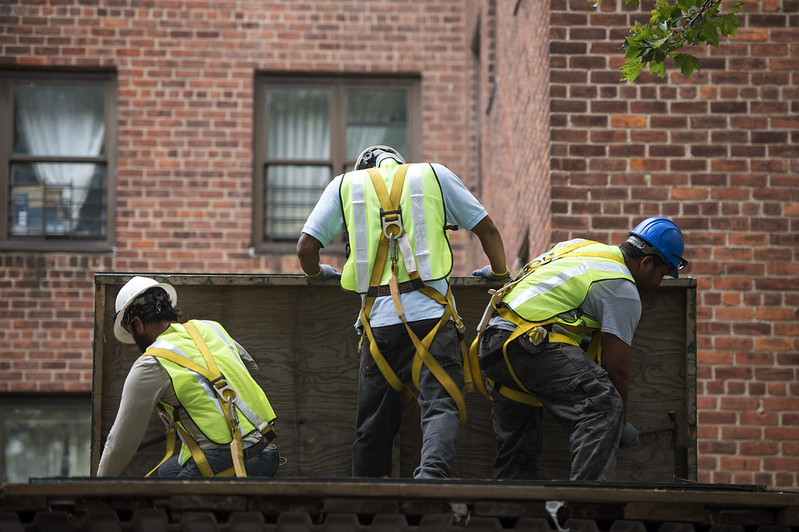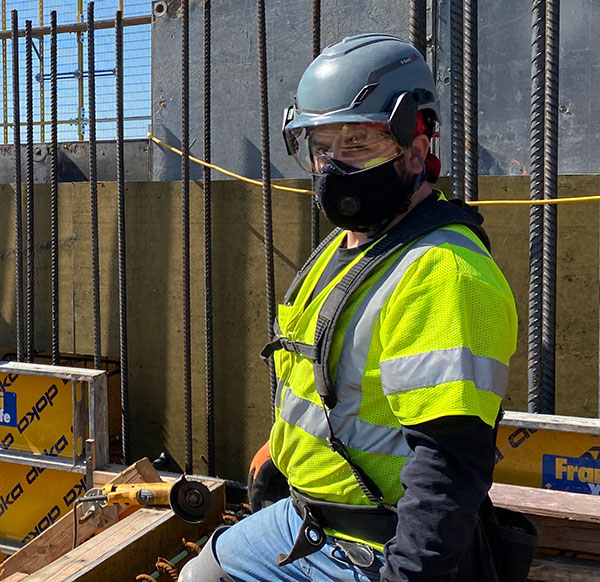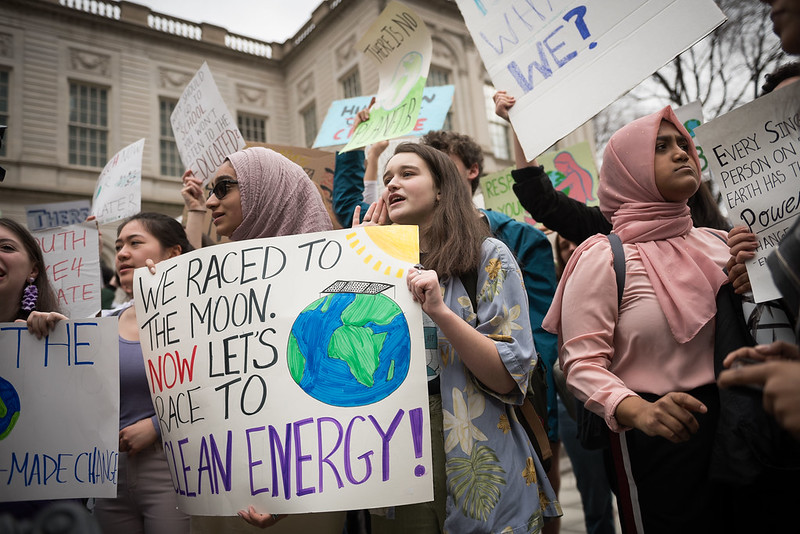As New York City Continues on Path to Recovery, City Officials Must Take Action to Protect Good Construction Jobs

(photo: Demetrius Freeman/Mayoral Photography Office)
Residents and businesses across the five boroughs continue to struggle as New York City begins the long process of economic recovery from the impacts of COVID-19. At times like these, it is the responsibility of city officials to not only create new opportunities but also to protect and sustain the jobs we have.
That is why, amid all the much-needed public discussions around workers in hard-hit sectors, the construction industry – which employed approximately 160,000 workers across New York City as of 2018 – must be part of the conversation, particularly as we currently face a major problem that threatens to leave thousands of the city’s construction workers unemployed.
New York City Local Law 196, which first required a minimum of 30 hours of training in 2019, now mandates that construction workers receive an additional 10 hours of Site Safety Training (SST) by September 1.
The problem is that with the deadline just one week away, it is increasingly obvious that a significant number of construction workers in our local workforce development network have not been able to receive the SST they need. While this is an unintended consequence of the city’s well-intentioned effort to support safety in New York’s construction industry, the current September 1 deadline must be adjusted so that every worker can get the additional 10 hours they need to remain employed.
New York City Department of Buildings (DOB) Commissioner Melanie La Rocca stated at a recent City Council hearing that the agency has “no objections to a Council proposal to delay the current September 1 deadline. This position builds on the strong precedent set by DOB when it comes to adjusting Local Law 196 deadlines to protect jobs for construction workers.
When the law was first implemented, DOB officials recognized that thousands of workers at that time did not have the 30 hours of training required in advance of the initial deadline of June 1, 2019. That is why the 30-hour deadline was pushed back and did not take effect until December 1 of that year.
As members of non-profit and workforce development groups from across New York City, we have heard about this issue directly from many of our constituents and workforce partners – and we are calling on DOB to formalize this decision as quickly as possible.
To be clear, this is not the fault of workers or their employers. Like basically everything else in New York City, SST providers were forced to shut down all of their training operations throughout the spring due to the pandemic – and many of these courses are still unavailable. Virtual SST courses do exist, but they have been so few and far between – not to mention deeply underfunded due to city budget challenges – that it is not possible to get every construction worker in the five boroughs trained by September 1.
Simply put, this means that all of the workers who have not been able to receive the additional training will lose their jobs. Their families will lose the income they need to pay for rent, food, healthcare, and any number of other essential components of their lives.
Everyone agrees that safety training for construction workers is important – but in these unprecedented times, we must not let city bureaucracy get in the way of sustaining employment for thousands of local residents in one of our largest and most economically vital industries. We hope DOB will take the next step by ensuring that this deadline is delayed and that jobs are protected.
***
David Meade is executive director of Building Skills New York; Jennifer Mitchell is executive director of The HOPE Program; Lakythia Ferby is executive director of STRIVE New York; Eileen Torres is executive director of BronxWorks; Valerie Payne is executive director of Rebuilding Together NYC; and Bishop Mitchell Taylor is CEO of Urban Upbound.
***
Have an op-ed idea or submission for Gotham Gazette? Email This email address is being protected from spambots. You need JavaScript enabled to view it.
Our Response to the Covid Crisis Shows Why Labor Unions are Essential

Union worker on the job during the coronavirus pandemic
Those who work in the industry have always known it, but COVID-19 made it clear to the public: construction is essential.
Through thick and thin, the unionized construction industry remains the vital sign of America. These workers erect critical infrastructure — from highways and airports to schools, government buildings, and health-care facilities. During times of crisis, these construction workers possess unique skills to quickly transform non-traditional spaces into critical care centers.
In the midst of this public health crisis and economic downturn, New York City Union Carpenters remained 20,000 members strong. While we couldn’t evade the pandemic’s advance, we met each day united and with a commitment to our members to be union strong. The shield at the base of the emblem in our logo symbolizes that those of us in the union are morally bound to safeguard and protect our members. That is a core value of our union, and during COVID-19 that is what we did.
When New York City was declared a hotspot for the virus, we took a stand and advocated that the government have a strict definition of what was considered essential, ensuring our members and their families remained safe and healthy.
We listened to and communicated with our members. We prioritized worker protections and seized every opportunity to alleviate financial stress. We were there to lend our support, share unemployment resources and protect every member who was out of work with our Benefit Funds.
We strived to ensure our members felt protected during this pandemic, offering supplemental PPE to fill gaps in contractor-provided PPE and providing information on new job site safety protocol and COVID-19 training courses. To guarantee our members’ questions were answered, we held Zoom webinars educating our shop stewards and foreman of the new normal safety standards.
These measures may seem like a no-brainer, yet, at the height of the pandemic, we saw many non-union workers on sites without adequate PPE. Time and time again, the kind of necessary support, expertise, and focus on safety we demonstrated has proven to be exclusive to the unionized construction industry.
When our state’s economy shut down, our union quickly realized that we were building a plane as we were flying it. Construction projects throughout New York City were still operating, and it was up to us to create a blueprint in keeping essential job sites safe.
As we came together with other Building Trades affiliates, contractors, developers, and real estate leaders, we saw that many other unions distributed face masks and provided free COVID-19 antibody testing. Together, we learned from one another and grew stronger.
We believe our industry is only as strong as its weakest link. The District Council will continue to serve as the voice for all workers across New York City, ensuring job sites are meeting or exceeding CDC and OSHA guidelines. The prevailing wage legislation we led the charge on and won in the middle of the pandemic is a testament to this. We advocate for all construction workers, union and non-union alike.
The unionized construction industry has not only built this great city and state but has also willingly and compassionately responded at its times of greatest need and peril. We are proud to be a guiding force and unwavering support system for our members and communities, now and always.
There is a long road to recovery ahead of us, and the New York City & Vicinity District Council of Carpenters will be there every step of the way.
***
Joseph Geiger, the Executive Secretary-Treasurer of the New York City & Vicinity District Council of Carpenters.
***
Have an op-ed idea or submission for Gotham Gazette? Email This email address is being protected from spambots. You need JavaScript enabled to view it.
A Peak Opportunity to Turn the Corner and Invest in Our Green New York Future

Pushing for a climate plan (photo: Ed Reed/Mayor's Office)
From Superstorm Sandy to Tropical Storm Isaías, climate change threatens all New Yorkers. That policymakers have largely not acted on this threat in a meaningful way is a profound failure. Now is the time to rectify that lack of action.
In New York at least, our new Democratic State Senate majority took power in 2019 and answered the call. Our Climate Leadership and Community Protection Act (CLCPA) is a nation-leading effort to fight back, putting our state on track for net zero greenhouse gas emissions and directing the benefits to communities that the fossil fuel industry left behind.
CLCPA commits New York to an equitable clean energy future – with 70% of electricity being renewable by 2030, 100% carbon-free by 2040, and an 85% emissions reduction overall by 2050. Crucially, at least 40% of investment is reserved for climate justice areas. These ambitious goals are critical, and they are the law. We must do what it takes to win this clean-energy future, secure a livable climate, and fully-fund a just transition for frontline communities.
The Queens waterfront is on the front lines of this battle, simultaneously home to numerous fossil fuel burning plants and NYCHA residents who suffer their effects. These streets are known as “Asthma Alley” due to the high rates of respiratory disease caused by pollution permeating the neighborhood. When everything works as intended at a fossil fuel plant, residents still get hurt. Pollution is no accident—it is a choice we make every time we expand fossil fuel infrastructure.
Neighborhoods nearest to these power plants are also among those hardest hit by COVID-19, the result of several factors including the cumulative impact of pollution, environmental racism, and income inequality driving incidence of respiratory illness. We must take special care to center public health as we consider the energy transition.
Corridors like Asthma Alley are most deserving of protection from the impact of burning fossil fuels, yet some energy companies seem determined to expand their carbon footprints, doubling down on burning fossil fuels that poison the community and heat our planet. With new technology and the CLCPA at the center of a new policy paradigm enabling us to transition away from environmentally hazardous power plants, why would we rubber-stamp new fossil fuel development?
There was a time when incremental progress could be deemed a success—when use of a less dirty but still damaging fuel may have been considered a step in the right direction. Insofar as using natural gas as a bridge to a renewable energy future was ever good policy, surely it has been spanned. The future is now. The work to meet the requirements of CLCPA and imbue New York energy policy with environmental justice has begun.
We know that once fossil fuel plants are built, they are difficult to decommission. In 2001, the New York Power Authority (NYPA) managed to eschew standard land-use protocols by claiming that emergency power plants were needed temporarily. NYPA pledged these plants would fire for only three years. Some of us sued to stop these “temporary” plants - and we won - but the plants remain operational nearly 20 years later.
Now there is a proposal to construct a natural gas ‘peaker plant’ in Astoria. Peaker plants feed the city additional power in times of high demand, running a relatively small number of days per year but requiring substantial fuel stores. And while natural gas is cleaner than kerosene, it is still a fossil fuel that does not move us quickly enough toward meeting the Earth-saving requirements of CLCPA.
Climate justice demands bold action now. CLCPA has raised the bar and we must meet it. This peaker plant proposal must be opposed. Despite game-changing laws like CLCPA, if this plant is built, like the wave of peakers constructed at the beginning of this century, we can expect it to remain in operation for decades. Even if we add renewable capacity after it is built, there will be pressure to keep it firing—and polluting—in order to make good on the investment required to build it and others.
In other words, new fossil fuel projects diminish our tenuous carbon budget and may be fiscally irresponsible on timelines that count: not financial quarters but over the lifetime of a capital investment and the lifetimes of people breathing polluted air.
The so-called “Astoria Replacement Project” needs replacing. Scrapping the proposal and focusing instead on clean power, innovative battery storage, and community empowerment will help meet the need to supercharge our energy policy in a just fashion. Let us muster the political courage necessary to force utilities to harness a clean alternative using an equitable process as quickly as they aspire to slip into our neighborhoods one of the last polluting power plants the law is likely to permit. Let us take this opportunity to refocus our energy economy towards public good and away from big corporations whose primary concern is the short-term profits of their executives and shareholders.
Think of the possibilities – for communities to reclaim open space, secure truly affordable housing, and win career-long green jobs – if solar fields, wind turbines, innovative battery storage, and community-owned renewables supplant dirty electricity. Let us think big and explore the possibility of placing the growing numbers of unemployed into workforce training that directly leads to well-paying jobs that stand the test of time. Let us build out a clean, electrified power sector so we can decarbonize the economy while advancing public health and frontline empowerment at every turn, ensuring that, for example, New Yorkers who drive can exchange their polluting tailpipe vehicles for electric cars.
We need to treat the energy industry as an integrated part of our overall economy and empower communities to harness it to provide sustainable job opportunities and environmental justice to their resilient neighborhoods. We need to seize the present opportunity to deliver on our commitment to clean energy and climate justice by stopping this misguided proposal for another peaker plant in Astoria.
***
Michael Gianaris serves as Deputy Majority Leader and represents western Queens in the state Senate. Harry Manin is a Sunrise NYC activist and climate policy advisor. On Twitter @SenGianaris and @sunrisemvmtnyc.
***
Have an op-ed idea or submission for Gotham Gazette? Email This email address is being protected from spambots. You need JavaScript enabled to view it.




